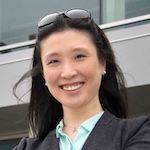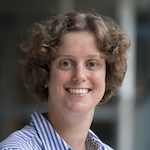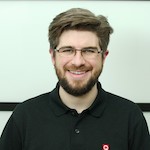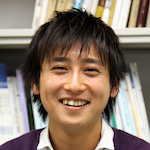This page lists the keynote speakers for the main session on Monday, August 15, and Tuesday, August 16. For workshop and tutorial speaker information, please see the individual agendas linked on the Workshops and Tutorials page.
 |
Karen Chen-WiegartAssistant Professor of Materials Science and Chemical Engineering Joint Appointment, National Synchrotron Light Source-II Bio Karen Chen-Wiegart is an Assistant Professor of Materials Science and Chemical Engineering at Stony Brook University. She also holds a Joint Appointment with the National Synchrotron Light Source – II (NSLS-II) at Brookhaven National Laboratory. The Chen-Wiegart research group emphasizes applying state-of-the-art synchrotron x-ray techniques to study materials kinetics such as their morphological, structural and chemical evolution, for functional applications. Her current interests include energy storage and conversion, nano-/meso-porous materials, molten salts, thin films & surface treatments, and 3D printing/additive manufacturing. Karen started her career as an undergraduate researcher at the Department of Materials Science and Engineering of National Taiwan University. Her PhD research at Northwestern University, funded by Advanced Photon Source, Argonne National Laboratory, focused on studying nanoporous metals with synchrotron imaging and microscopy, including x-ray nano-tomography. Before joining Stony Brook University, she conducted her postdoctoral research on studying energy storage and conversion materials with x-ray microscopy at Brookhaven National Laboratory, and then became a beamline scientist at the Sub-Micron Resolution X-ray Spectroscopy Beamline of NSLS-II. Karen was the recipient of the 2022 TMS Frontiers of Materials Award and the National Science Foundation CAREER Award in 2018 for her study of nano-/meso-scale bicontinuous metallic structures. She and her group have been participating in two Energy Frontier Research Centers supported by the Department of Energy and also partnering with industrial collaborators. Karen is active in educational and outreach programs at Stony Brook University, Brookhaven National Laboratory, and local communities. |
 |
Ireen GrootAssistant Professor Bio Irene Groot obtained her PhD degree at Leiden University investigating the dissociation of hydrogen on single crystals, both experimentally using supersonic molecular beams and theoretically performing density functional theory and quantum dynamics calculations. After a postdoc at the Fritz Haber Institute in Berlin, she went to the Leiden Institute of Physics with a personal Veni fellowship from the Netherlands Organization for Scientific Research. Currently, Irene Groot is associate professor (tenured) at the Leiden Institute of Chemistry where she is heading the operando catalysis research group. She investigates the structure-activity relationship of catalysts under industrial conditions using operando scanning probe microscopy, transmission electron microscopy, Raman spectroscopy, and x-ray-based techniques. She focuses on industrial processes related to sustainable energy and materials production. Current topics in her group are hydrodesulfurization, Fischer-Tropsch synthesis, methanol steam reforming, automotive catalysis, chlorine production, methanol steam reforming, and graphene growth on liquid copper. |
 |
Tom HoganApplications Scientist Bio Tom Hogan graduated from Boston College with a PhD in Physics where his studies focused on the effects of charge doping on correlated electron systems. As part of that work, he synthesized materials and characterized them using x-ray and neutron diffraction techniques at several national user facilities. Techniques employed included triple-axis diffraction, REXS, RIXS, and time-of-flight Laue diffraction. Presently, as an Applications Scientist, Tom supports customers leveraging Quantum Design’s suite of measurement options to quantify electrical, magnetic, and thermal properties at cryogenic temperatures and high magnetic fields, as well as extending the utility of those tools for custom applications. |
 |
Linda HortonAssociate Director of Science for Basic Energy Sciences Bio Dr. Linda L. Horton is the Associate Director of Science for Basic Energy Sciences (BES) in the Department of Energy (DOE) Office of Science (SC). With an annual budget of more than $2 billion, BES is the nation’s leading supporter of fundamental research in materials sciences, chemistry, geosciences, and aspects of biosciences. BES is also a major supporter of scientific user facilities, including the nation’s premier x-ray light sources, neutron scattering facilities, and nanoscale science research centers. These facilities serve over 16,000 users annually, and they provide the tools for the preparation and examination of materials and the study of their physical and chemical properties and transformations. Previously, Dr. Horton was the Director for the Materials Sciences and Engineering (MSE) Division in BES. Since joining DOE in 2009, Dr. Horton has been extensively involved in interdepartmental coordination activities, including serving as the DOE-SC management lead for batteries and energy storage, the SC Early Career Research Program, and is the past co-chair for the OSTP-led Materials Genome Initiative. Her BES roles have included interim leadership of the management team for the newly established Energy Frontier Research Centers. She has served as the materials lead for international activities that included workshops with the European Union on energy storage and critical materials. As part of the BES communication strategy, she had lead responsibility for the “Science Serving the Nation” brochure. Since 2016, she led the BES teams responsible for 7 strategic “basic research needs” workshops/roundtables and the associated brochures and reports. Prior to joining BES, Dr. Horton was the Director of the Center for Nanophase Materials Sciences at Oak Ridge National Laboratory, one of the five DOE national user facilities for nanoscale science research. Her personal research emphasized applications of electron microscopy to materials science problems including investigations of the effects of ion implantation and neutron irradiation and studies of the growth and characterization of diamond thin films. She is a Fellow of ASM International and has served on several national and international advisory committees. In professional service, she has been an officer of the Materials Research Society and of the Microscopy Society of America, Trustee of ASM International, and Vice-Chairman of the DOE Basic Energy Sciences Advisory Committee. Her Ph.D. in Materials Science is from the University of Virginia. |
 |
Hideaki IwasawaPrincipal Researcher, Institute for Advanced Synchrotron Light Source Bio Hideaki Iwasawa is a principal researcher in the Institute for Advanced Synchrotron Light Source at National Institutes for Quantum Science and Technology (QST), Japan. He received his Ph.D. in Physics from the Tokyo University of Science for studying electronic structures of strongly correlated electron systems such as layered perovskite superconductors using angle-resolved photoemission spectroscopy (ARPES). Following his Ph.D. studies, he worked on developing and utilizing ARPES systems in synchrotron facilities, the Hiroshima Synchrotron Radiation Center at Hiroshima University, and Diamond Light Source. He currently works to develop a novel ARPES beamline with superior spatial resolutions at a new soft x-ray synchrotron radiation facility, NanoTerasu, in Tohoku, Japan. His recent research has centered on microscopic electronic structures of quantum materials by combining spatially-resolved ARPES and machine-learning-based analysis techniques. |
 |
Terry McAfeeSenior Scientific Engineering Associate, Advanced Light Source Bio Terry McAfee is a first generation college student born and raised in California. He went to CSU Chico for a BS in Physics. He continued his physics education at North Carolina State University (NCSU), where he received a Ph.D researching the properties of organic solar cells using x-rays. After a postdoc at Tulane University researching automated control of polymer synthesis, he return to the ALS as a postdoc developing a technique for in-situ soft x-ray scattering of polymers in solution. In May 2021, Terry was hired by the ALS as a scientific engineering associate for the Ambient Pressure XPS program. |
 |
Beatriz Roldán CuenyaDirector, Interface Science Department of the Fritz Haber Institute Bio Prof. Dr. Beatriz Roldán Cuenya is currently the director of the Interface Science Department of the Fritz Haber Institute (FHI) of the Max Planck Society in Berlin (Germany). She began her academic career by completing her MSc in Physics in Spain in 1998 and a PhD in Physics in Germany in 2001. Her postdoctoral research took her to the Department of Chemical Engineering at the University of California Santa Barbara (USA). In 2004, she joined the Department of Physics at the University of Central Florida (UCF) as Assistant Professor becoming a full professor in 2012. In 2013, Beatriz Roldán Cuenya became a chair professor of Solid State Physics at the Ruhr-University Bochum (Germany). She then moved to the FHI in 2017. Prof. Dr. Beatriz Roldán Cuenya is the author of more than 190 peer-reviewed publications and 4 book chapters. She is Associate editor of ACS Catalysis and serves in the editorial board of the Journal of Catalysis and Chemical Reviews. She has received a number of awards including the Faraday Medal from The Electrochemistry Division of the Royal Society of Chemistry (2022), the Paul H. Emmett Award from the North American Catalysis Society (2022), the Röntgen Medal of the City of Remscheid (2022), the International Society of Electrochemistry-Elsevier Prize for Experimental Electrochemistry (2021), and the Peter Mark Memorial Award of the American Vacuum Society (2009). She is also a Fellow of the American Vacuum Society (2021), and a member of the Academia Europaea (2020). |
 |
Edbert SieOptical Systems Scientist, Reality Labs Research Bio Edbert Sie is an optical systems scientist at Reality Labs Research at Meta (formerly Facebook). His research interests lie at the intersection of human-computer interfaces, biosensing, and AR/VR. His recent projects include developing high-sensitivity optical systems to measure neural activity towards a brain-computer interface. He received his PhD in physics from MIT in 2017 and was a postdoctoral fellow at Stanford until 2019, where he led research in ultrafast optics from THz, XUV, to electron diffraction in quantum materials. |
 |
Francesca TomaStaff Scientist Bio Dr. Toma is a Staff Scientist at Lawrence Berkeley National Laboratory and the Technology Lead for Photoelectrochemistry in the HydroGEN Consortium. At LBNL, she is also the Program Lead for the Liquid Sunlight Alliance. She is an expert in materials synthesis and characterization. In her career, she has worked with several classes of materials spanning energy research and nanomedicine. She got her PhD in Italy at the International School of Advanced Studies, before moving as a postdoc at the University of California Santa Barbara first, and Berkeley afterwards. She received several awards including being selected as one of the “100 Women of Materials Science” by the Royal Society of Chemistry in 2018, the ACS Rising Star Award in 2021, and in 2022 she became an Oppenheimer fellow in the Oppenheimer Science and Leadership Program of the National Laboratory Directors’ Council. |